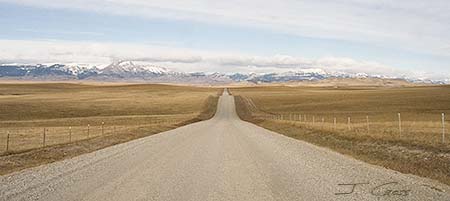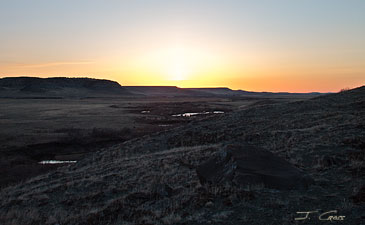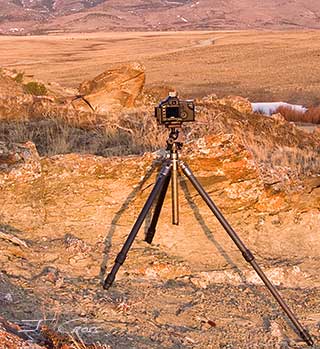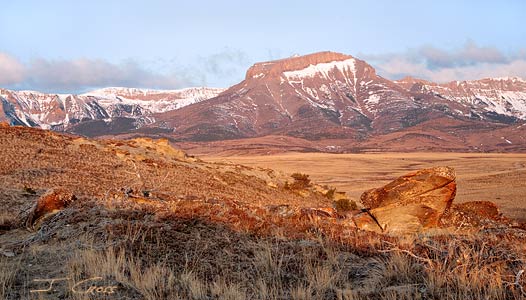www.lumen-perfectus.com
The Making of a Photograph
"Every picture tells a story, don't it?" (Rod Stewart)
Every year in March, hundreds of thousands of snow geese, thousands of tundra swans, and large numbers of other birds stop at Freezeout Lake between Choteau and Fairfield, along Montana's Rocky Mountain Front. The geese are coming from their winter homes in the southwest and the southern coast of California. The Freezeout Lake Wildlife Management Area consists of several lakes which offer the birds a safe haven during this spring migration. Here they can rest and refuel for a few days before moving on to spend the summer in their arctic breeding grounds. Twice a day the birds fly out to, or return from, the nearby barley fields, where they find plenty of grain left from last year's harvest. The simultaneous launch of thousands of large birds is a spectacle of sight and sound, an event not to be missed for bird watchers (and photographers!).
I've gone to the lakes each March for the last several years. As is true for many things in life, timing is everything if one wants to see the maximum numbers of birds. The first year I saw few birds. I was perhaps a week late. Other years have been better on those same dates. The last week of March 2009 was perfect, and I brought back a large number of successful photos of bird clouds, bird close-ups, and a couple of nice landscapes.
The area around the lakes is normally fairly quiet at this time of year. But once the Great Falls Tribune re-runs its annual "THE BIRDS ARE BACK!!!" article, the area can become pretty crowded, especially on the peak weekends, as people, like the birds, flock to the lakes. For that reason I arrive mid-week when there are few visitors. Most of the weekday people are serious birders, have come along with serious birders, or are photographers. Note that these are not mutually exclusive groups. If you go, take all your optical gear. Since thousands of birds may be flying over you, wear a hat.
Since I'm coming from Montana's Mission Valley, west of the Continental Divide, my trip to the lakes takes me past Glacier National Park. Truth be told, I don't pass. I'm unable to simply drive by the park; I time my travel so I arrive there for golden hour photography — in late March this is roughly a half-hour before sunrise to about 9:00 AM. After photographing around Lake McDonald for a while I drive east over Marias Pass, through Browning, and then south on US 89 to arrive in Choteau by mid-afternoon.
More Than Birds
The area along the Rocky Mountain Front, that is, just east of the mountains in northern Montana, is stunningly beautiful. If one never saw a snow goose, or tundra swan, or any other bird while at Freezeout Lake, one would still find endless photo opportunities. My trips to Freezeout Lake often yield some nice bird photos, but the majority of my keepers from the 2010 visit are landscapes.
I love going to Freezeout Lake and photographing the birds. Even when conditions aren't great, or when I've missed the peak bird numbers, I always have a wonderful time photographing there. Since I'd spent a lot of time at the lakes and the surrounding fields during previous trips, I decided to make time this year to explore a bit farther afield.
A place I've wanted to see up close is Ear Mountain, a Montana State Wildlife Management Area. With a height of 8500 feet (2600 meters), the mountain dominates the view of the Front from most anywhere in Teton County. Photographing birds at the lakes, I'd used up the good light on my first morning there. The wind was increasing to uncomfortable levels. It seemed a good opportunity to scout new locations, so I drove west out of Choteau on Bellview Road. This is 22 miles of chokingly dusty gravel washboard. I kept my speed down and spent nearly an hour getting there. The wind was really screaming, but the dust I raised still managed to settle on my small SUV in layer upon layer. At times it was quite difficult to see, but the mountains loomed large in front of me the entire drive.

An atypically smooth stretch of Bellview Road. You can see the front range 20 miles ahead.
Fifteen miles into my drive, with the Front filling the horizon, I began looking for good compositions and shooting locations. My plan, if I liked what I saw on this scouting trip, was to return before dawn tomorrow and wait for the golden light of sunrise. I visualized the strong light behind me, lighting the face of the mountains as it would in the morning.
I stopped frequently, getting out of the car to look around, wandering a bit off either side of the road. The wind and blowing dust made this unpleasant. My trip ended at the closed gate of the WMA. The area is closed for the winter from December into May, but I had no need to enter. I'd found the location and a couple of backups for my morning shoot a few miles before the gate. I'd taken some test pictures and would view those in my room this evening to confirm my choices and note the locations. This was necessary because I'd be arriving in the dark tomorrow and things would likely look very different.
I was inspired by everything here, except the wind. I had high hopes for a clear eastern sky at sunrise, so I decided to return for the sunrise shoot. I also hoped the wind would calm by morning.
(Almost) Gone With the Wind
The wind did not calm by morning. It howled and rattled around my hotel all night. What did people say wind sounded like before there were freight trains? Wind presents challenges, and for an outdoor photographer, it can make working nearly impossible. The wind beats up the photographer while he's trying to get the shot and makes for an exhausting day. Telephoto (long) lenses are commonly used for bird photography. A camera with a long lens, made even longer by its lens hood, acts like a sail in strong wind. This causes the camera to vibrate on the tripod, and can even topple the entire rig if one isn't careful when setting up. Carbon fiber has a number of benefits over aluminum as a material used in tripod construction, including a superior ability to damp vibration. But in these winds even the magic of CF is of little help. Lens changes in such conditions are impossible; even a light breeze blows all manner of crud and grit into the camera during a lens change. Such stuff has a knack for collecting on the imaging sensor in a digital camera, resulting in spots on the pictures. In these conditions I try to avoid lens changes, but when necessary, I make them inside the car. For this outing I'd selected and installed my wide-angle zoom lens while still in my room.
I left my hotel in the dark at 5:00 AM. I retraced my rough, dusty drive of the previous afternoon, watching carefully for eyes shining in my headlights. Deer are plentiful along the route; at the very least, an "encounter" would have delayed my arrival and ruined my plans (and likely those of the deer). When I arrived at my preferred location it was still quite dark, and the wind was worse than it had been when I departed town. Air piles up on the west side of the Rockies and is shoved over the tops of the mountains. As it runs down the east side it trips over its own feet and tumbles out of control to the valley floor, picking up speed as it falls.
This is a windy place. To people living along the Front, a sustained 20 mph wind is a trifle. On this day I'd have have been happy with a "breeze" of only 20 mph. The wind was easily blowing 45 mph, with gusts reaching 60. At times it was difficult to stand still in the open, and the gusts felt like blows administered by an NFL offensive tackle. Opening the car door against the wind was difficult. It was 26°F (-3°C); just thinking about the wind chill was painful. It was going to be a tough morning.
"Old timers used to say that a Wyoming wind gauge was an anvil on a length of chain." (David Love, in John McPhee's Rising from the Plains.) I wasn't in Wyoming, of course, but at the base of Ear Mountain this morning, such a gauge might have been adequate if it had a stout chain.
Setting Up

What Mom taught you about crossing streets applies when photographing sunrises (or sunsets): look both ways.
One of my scouted locations included a low wall of rock behind which I could set up my tripod and gain a little protection from the wind. With some care I was able to pull the car off the road and park near that spot. As the dark eastern sky behind me slowly colored and brightened and I could see a little more of my surroundings, I began to see other compositions both toward the mountains and to the east. Exiting the car and using it as a shield against the wind, I set up my tripod and camera. This was less effective than I'd hoped, but I was able to make some exposures of the eastern sky and the dark, alien-looking landscape at my feet.
Although the sun hadn't yet cleared the horizon, it wasn't long before the eastern sky was washed out, the color gone. Apparently there was enough haze to turn the sky white even before the sun's arrival. As you'd expect, the mountains to the west were still in shadow. There was as yet no light on the goal of my trip.

The setup. The shadow of the tripod is on the ridge of stone that provided a bit of a windbreak.
I moved the tripod to the location behind the rock wall. I could keep the tripod low, extending its legs only enough to make it level and to place the camera just above the rock wall. As I aimed the camera at the mountains, the wind was blowing directly into the lens and my face. I framed my composition, removed the camera from the tripod, and returned to the car to wait for good light on the mountains. Waiting is something photographers do a lot — this isn't a profession (or hobby) for the impatient. The wait provided an opportunity to open a chemical hand-warmer, which helped bring some feeling back to my fingers. How we suffer for our art!
Through the windshield I watched the mountains; in the mirror I watched the eastern sky. If the milky haze there thickened I might get no light at all. The mountains could remain in shadow until the sun had climbed beyond the good light. It wouldn't be the first time the effort to make a picture was wasted, the opportunity lost at the last minute. But I still had high hopes.
Sunrise, and Getting the Shot
Finally, the sun rose, as it always does. The mountains lit nicely, but the local (foreground) rock was still in shadow. I had hoped for great light on both, but as the minutes ticked away (blew away?) it became clear I'd have only a moment to capture nicely lit mountains and great color in the foreground. I'd have to be ready, which meant waiting out in the wind. I made my move, clamped the camera to the tripod, hunkered down behind the rocks, and waited. I was feeling a little panicky because the sky above the mountains was quickly losing color. It was coming down to seconds. Finally the moment came and I got my shot. I framed a second composition from a slightly different location, but the original composition is the better image. The moment had passed. I made a leisurely drive back to town for a hot breakfast out of the wind.
There is an impressive forest of aspen trees along the base of Ear Mountain. This is not visible in my photo because the mountain is several miles away and the trees have not yet leafed out. In the fall the birds will stop once again at Freezeout Lake on their long flight back to California. Like them, perhaps I'll return in September when the aspens are in their golden splendor.
Is the photograph worth the effort required to make it? I think so, and I'm happy to have the picture in my portfolio. Let me know what you think.

Ear Mountain at Sunrise
April, 2010